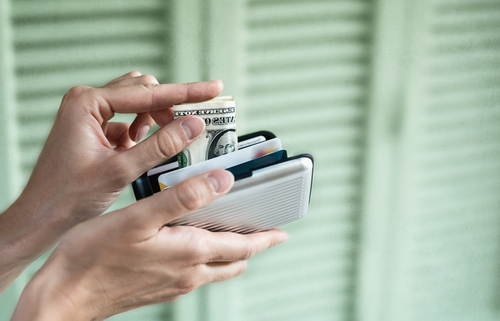In a world where digital convenience is king, protecting your personal information has never been more important. You may have heard about RFID blocking wallets and wondered if they are a necessary accessory. This guide will explain what an RFID blocking wallet is, how it works, and whether you actually need one. Understanding this technology can help you make an informed decision about safeguarding your sensitive data.
What is RFID Technology?
Before we can understand RFID blocking wallets, we need to know what RFID is. RFID stands for Radio-Frequency Identification. It’s a technology that uses radio waves to identify and track tags attached to objects.
An RFID system consists of two main parts:
- A tag or smart label: This contains a microchip that stores information.
- A reader: This is a device that sends out a radio signal.
When the reader’s signal reaches the tag, the tag is powered up and sends its stored information back to the reader. You encounter this technology every day, often without realizing it. It’s used in things like electronic toll collection, inventory tracking, and, most importantly for this topic, in your credit cards, debit cards, and passports.
These items often contain an RFID chip that allows for “contactless” payments or quick identification. You can simply tap your card on a payment terminal without needing to swipe or insert it. This convenience is great, but it also brings up security concerns.
How Does an RFID Blocking Wallet Work?
An RFID blocking wallet is designed to stop RFID readers from accessing the information on your cards without your permission. It creates a protective shield around your cards, making them invisible to unauthorized scans.
These wallets are typically made with a material that blocks radio waves, most commonly carbon fiber or aluminum. This material is woven into the lining of the wallet, creating what is known as a Faraday cage.
A Faraday cage is an enclosure used to block electromagnetic fields. When an RFID reader sends out its signal, the material of the wallet absorbs it and prevents it from reaching the RFID chips in your cards. As a result, the chips cannot power up and cannot transmit their data. It’s a simple yet effective way to protect your information from a specific type of theft known as RFID skimming.
What is RFID Skimming?
RFID skimming is a form of digital theft where a criminal uses a portable RFID reader to secretly scan and copy the information from your RFID-enabled cards. This can happen without you ever knowing it, as the scanner doesn’t need to physically touch your wallet. A thief could potentially walk by you in a crowded place and capture your card details from a short distance.
With the information skimmed from your card, a thief could create a clone of your card or use the details to make fraudulent online purchases. This is the security threat that RFID blocking wallets are designed to prevent.
Do You Really Need an RFID Blocking Wallet?
The risk of RFID skimming is real, but it might not be as widespread as some marketing suggests. Modern credit cards have several layers of security that make this type of fraud difficult.
Here are a few points to consider:
- Encryption: Most modern contactless cards use advanced encryption. Even if a scanner could read the card’s number, it might not be able to capture the critical data needed to authorize a transaction.
- One-Time Codes: Many new cards generate a unique, one-time code for each transaction. This means that even if a skimmer captured the data from one transaction, it would be useless for making another one.
- Limited Range: RFID readers need to be quite close to your cards—usually within a few inches—to work. This makes mass skimming in public more challenging than it might seem.
Despite these protections, some people prefer the extra peace of mind that an RFID blocking wallet provides. If your credit cards have the contactless payment symbol (which looks like a Wi-Fi symbol turned on its side), they are RFID-enabled. The decision to use a protective wallet often comes down to personal comfort and your individual risk tolerance.
Protect Your Personal Information
An RFID blocking wallet is a simple tool designed to protect your contactless cards from unauthorized scanning. It uses materials like carbon fiber or aluminum to create a shield that blocks the radio waves used by RFID readers.
While modern credit cards have robust security features, the threat of RFID skimming still exists. Deciding whether you need an RFID blocking wallet depends on your personal sense of security. It’s an affordable and easy way to add an extra layer of protection to your daily life, ensuring your financial information stays safe and secure.
Frequently Asked Questions (FAQs)
Q: What is RFID skimming?
A: RFID skimming is a technique used by criminals to steal sensitive information stored on RFID-enabled cards, such as credit cards or IDs, by using a reader to access the data without physical contact.
Q: How does an RFID blocking wallet work?
A: An RFID blocking wallet creates a protective barrier that disrupts or blocks the electromagnetic signals needed for RFID readers to access your card information. This prevents unauthorized scanning and keeps your data secure.
Q: Do all wallets have RFID blocking technology?
A: No, not all wallets are equipped with RFID blocking technology. Only wallets specifically designed with materials that block RFID signals can provide this type of protection.
Q: Is an RFID blocking wallet necessary for everyone?
A: It depends on your personal security concerns and whether you frequently carry RFID-enabled cards. While RFID skimming is not extremely common, an RFID blocking wallet offers extra peace of mind and protection.
Q: Can RFID blocking wallets interfere with devices or card usage?
A: No, RFID blocking wallets will not interfere with your ability to use your cards. They only block signals from unauthorized RFID readers, not legitimate transactions where the card is physically used.
